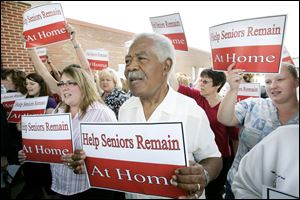
Seniors, aides protest planned cuts to Medicaid
7/2/2009
Kylie Moore, left, and Norman A. Bell, Sr., gather during a Help Seniors Remain at Home rally at Margaret Hunt Senior Center.
Margaret Bryant would rather die than live in a nursing home.
For more than a decade, the 67-year old spitfire has lived in her own quarters in an apartment center for senior citizens on Arlington Avenue.
She is independent but not alone.
Four times a week for three hours at a time, a home health aide comes to assist her - among other things, preparing meals and changing the water in her humidifier.
A skilled nurse comes to check her twice a week. And she has an emergency button - just in case.
"I have my own, individual space," she said of life at the senior center. "It's not like someone else controlling my life, telling me what to or not to do."
But if Governor Ted Strickland has his way, it will become significantly more difficult for people such as Mrs. Bryant to receive the long-term care they require while maintaining their independence.
As part of his plan to trim $2 billion from Ohio's budget, the governor is considering cuts of 18 percent of funding from the PASSPORT Medicaid Home Care program for seniors, the program that has allowed Mrs. Bryant and thousands of senior citizens across Ohio to maintain their independence.
Cuts in PASSPORT funding would force more senior citizens to enter nursing homes, putting additional strain on the state's Medicaid budget, according to Northwest Ohio's Area Office on Aging, a private, nonprofit corporation.
"Our PASSPORT consumers do need to meet a nursing-home level of care," said Pam Wilson, vice president of long-term care with the Office on Aging. "They are unable to take care of their own body and need assistance doing things like bathing, getting dressed, feeding themselves."
She explained that if the proposed cuts go through, it would be much more difficult for PASSPORT to admit new members and that it is not yet clear whether the cuts would affect the services that PASSPORT provides to its existing consumers, a source of consternation for members.
Ms. Wilson said she was not able to say which taxes should be raised or what cuts should be made to other agencies to avoid cuts to the PASSPORT program.
After the governor's announcement, an elderly woman with a history of heart problems needed to go to the hospital because the proposed cuts so upset her, Beth Czajka, a caseworker with PASSPORT, said.
At least 800 seniors will not be admitted to the program as a result of the two-year funding cut, the Office on Aging estimates.
Those put on the resulting wait list typically choose to enroll in full-time assisted living facilities rather than wait for a spot to open up, Ms. Wilson said, at three times the cost to the taxpayer.
"A person can stay on the wait list," she said. "However, depending on their circumstances, it becomes extremely difficult to get people out [of the nursing homes.] Even if people are physically able."
She said that once in a nursing home, individuals are only allowed to keep $1,500 in savings, which more often than not makes reestablishing their independence prohibitively expensive.
As a result of the increased nursing home enrollment, the Office on Aging estimates, a $40 million cut from PASSPORT, would result in increased costs to the state of $102 million.
"Many states are looking at trying to make the home-care option readily available and urging people to look at home care first because it is less costly," Ms. Wilson said.
Yet the governor's plan, by making home care a less accessible option than nursing home care, points Ohio in the opposite direction.
Indeed, according to the Ohio Business Roundtable, if Ohio were to shift its Medicaid spending from nursing home care to home care and match the national average, the state would save $900 million per year.
Seventy-five percent of Ohio's per-capita, long-term care Medicaid spending is on nursing homes and 25 percent is on home care. Nationally, those figures are 61 percent to 39 percent, respectively.
And therein lies the problem.
The solution, Ms. Wilson said, is to make the community aware of the available long-term care services.
"We want the state to make people aware that PASSPORT is available," she said. "Usually, people just think of nursing homes."
At three times the cost to the taxpayer of at-home care, nursing homes are not fiscally efficient, Ms. Wilson said.
Contact Florence Dethy at:
fdethy@theblade.com
or 419-724-6064.